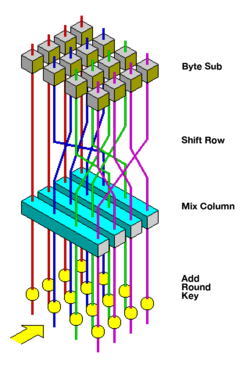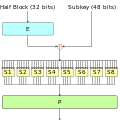Symmetric-key algorithms are algorithms for cryptography that use the same cryptographic keys for both the encryption of plaintext and the decryption...
15 KB (1,540 words) - 21:14, 19 June 2025
of security inherent in the key length). Most symmetric-key algorithms are designed to have security equal to their key length. However, after design...
29 KB (3,225 words) - 14:31, 21 June 2025
intensive than symmetric ones, it is common to use a public/private asymmetric key-exchange algorithm to encrypt and exchange a symmetric key, which is then...
40 KB (4,551 words) - 23:23, 28 July 2025
Advanced Encryption Standard (redirect from Rijndael encryption algorithm)
(DES), which was published in 1977. The algorithm described by AES is a symmetric-key algorithm, meaning the same key is used for both encrypting and decrypting...
50 KB (5,679 words) - 04:23, 27 July 2025
processed through a cryptographic algorithm, can encode or decode cryptographic data. Based on the used method, the key can be different sizes and varieties...
13 KB (1,517 words) - 06:00, 3 August 2025
wrapping key Symmetric key wrapping keys are used to encrypt other keys using symmetric key algorithms. Key wrapping keys are also known as key encrypting...
10 KB (1,385 words) - 15:15, 16 June 2025
types of keys, with some systems using more than one. These may include symmetric keys or asymmetric keys. In a symmetric key algorithm the keys involved...
34 KB (3,512 words) - 23:43, 24 May 2025
Data Encryption Standard (redirect from Data Encryption Algorithm)
Standard (DES /ˌdiːˌiːˈɛs, dɛz/) is a symmetric-key algorithm for the encryption of digital data. Although its short key length of 56 bits makes it too insecure...
60 KB (6,717 words) - 14:31, 5 July 2025
(AES). Ronald L. Rivest, US, MIT, inventor of RC cipher series and MD algorithm series. Bruce Schneier, US, inventor of Blowfish and co-inventor of Twofish...
22 KB (2,471 words) - 15:52, 16 July 2025
Diffie–Hellman (DH) key exchange is a mathematical method of securely generating a symmetric cryptographic key over a public channel and was one of the...
47 KB (5,306 words) - 22:17, 27 July 2025
Cipher (section Key size and vulnerability)
same key is used for both encryption and decryption (symmetric key algorithms), or if a different key is used for each (asymmetric key algorithms). If...
18 KB (2,152 words) - 16:42, 23 July 2025
256 bit keys Elliptic-curve Diffie–Hellman and Elliptic Curve Digital Signature Algorithm with curve P-384 SHA-2 with 384 bits, Diffie–Hellman key exchange...
10 KB (655 words) - 20:05, 23 June 2025
Kerberos (protocol) (category Symmetric-key algorithms)
described in RFC 3244. In case of symmetric cryptography adoption (Kerberos can work using symmetric or asymmetric (public-key) cryptography), since all authentications...
27 KB (3,023 words) - 15:26, 31 May 2025
WEP-protected network shares the same WEP key. Encryption uses the RC4 algorithm, a stream cipher. It is essential that the same key never be used twice with a stream...
5 KB (688 words) - 10:33, 3 January 2025
key. In real-world situations, it is often also used with encryption using symmetric key algorithms like the Advanced Encryption Standard algorithm....
104 KB (11,929 words) - 03:48, 2 August 2025
Message authentication code (redirect from Message Authentication Algorithm)
generation algorithm selects a key from the key space uniformly at random. A MAC generation algorithm efficiently returns a tag given the key and the message...
16 KB (1,918 words) - 14:30, 11 July 2025
Private-key cryptography (symmetric key algorithm): one shared key is used for encryption and decryption Public-key cryptography (asymmetric key algorithm):...
9 KB (1,133 words) - 21:23, 27 July 2025
The Cayley–Purser algorithm was a public-key cryptography algorithm published in early 1999 by 16-year-old Irishwoman Sarah Flannery, based on an unpublished...
7 KB (1,139 words) - 08:53, 19 October 2022
Pretty Good Privacy (redirect from PGP key pair)
symmetric-key encryption and public-key encryption. The message is encrypted using a symmetric encryption algorithm, which requires a symmetric key generated...
57 KB (6,276 words) - 02:52, 30 July 2025
Blowfish (cipher) (redirect from Blowfish encryption algorithm)
Blowfish is a symmetric-key block cipher, designed in 1993 by Bruce Schneier and included in many cipher suites and encryption products. Blowfish provides...
18 KB (2,000 words) - 15:11, 16 April 2025
International Data Encryption Algorithm (IDEA), originally called Improved Proposed Encryption Standard (IPES), is a symmetric-key block cipher designed by...
12 KB (1,499 words) - 19:07, 14 April 2024
Ratchet Algorithm's design is based on the DH ratchet that was introduced by Off-the-Record Messaging (OTR) and combines it with a symmetric-key ratchet...
15 KB (1,391 words) - 14:17, 28 July 2025
generate keys is called a key generator or keygen. Modern cryptographic systems include symmetric-key algorithms (such as DES and AES) and public-key algorithms...
5 KB (698 words) - 04:27, 19 May 2025
cryptography, the Elliptic Curve Digital Signature Algorithm (ECDSA) offers a variant of the Digital Signature Algorithm (DSA) which uses elliptic-curve cryptography...
22 KB (2,997 words) - 15:01, 22 July 2025
the cipher key called a round key. A key schedule is an algorithm that calculates all the round keys from the key. Some ciphers have simple key schedules...
3 KB (402 words) - 08:19, 29 May 2025
some rotor machines, most notably the Enigma machine, embodied a symmetric-key algorithm, i.e., encrypting twice with the same settings recovers the original...
17 KB (2,462 words) - 12:35, 29 November 2024
conversations. OTR uses a combination of AES symmetric-key algorithm with 128 bits key length, the Diffie–Hellman key exchange with 1536 bits group size, and...
21 KB (1,884 words) - 16:43, 3 May 2025
confidentiality (encryption). Typically, a cryptosystem consists of three algorithms: one for key generation, one for encryption, and one for decryption. The term...
4 KB (497 words) - 22:26, 16 January 2025
In cryptography, the Tiny Encryption Algorithm (TEA) is a block cipher notable for its simplicity of description and implementation, typically a few lines...
13 KB (1,189 words) - 16:09, 1 July 2025
One-key MAC (OMAC) is a family of message authentication codes constructed from a block cipher much like the CBC-MAC algorithm. It may be used to provide...
9 KB (919 words) - 07:00, 12 July 2025













